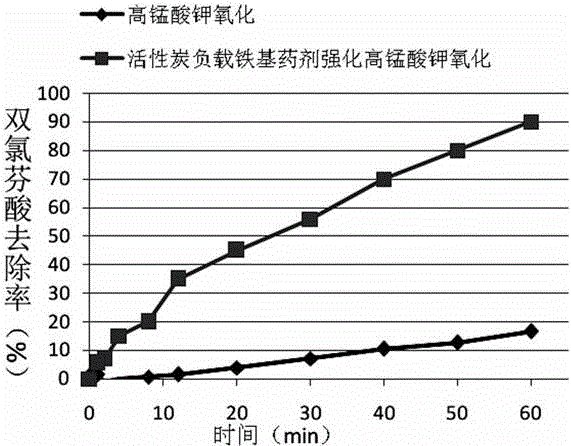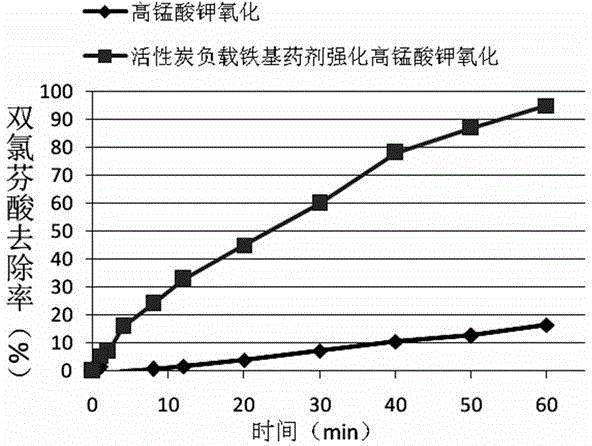Method of removing micro organic pollutants in water
A technology for removing organic pollutants and water, applied in the field of water treatment, can solve the problems to be investigated, high cost of catalysis, inability to realize recovery and utilization of catalysts, etc. Effect
- Summary
- Abstract
- Description
- Claims
- Application Information
AI Technical Summary
Problems solved by technology
Method used
Image
Examples
Embodiment 1
[0039] Take 200mL of river water (taken from the Yangtze River) containing trace organic pollutants, and control FeO / AC+Fe 2 o 3 The dosage of AC / AC (mass ratio 1:4) is 15mg / L. After stirring vigorously with a magnetic stirrer for 10 minutes, potassium permanganate is added. The dosage of potassium permanganate is 5mg / L. After 1 hour of treatment, the removal rate of trace organic pollutants can reach 35%-90%. Compared with the single use of potassium permanganate, the removal rate of trace organic pollutants in this embodiment is increased by 35%-600%, and the reaction rate is increased by 3-10 times.
[0040] figure 1 It is the effect diagram of this embodiment on the removal of trace organic pollutants, and the trace organic pollutants are taken by non-steroidal anti-inflammatory drug—diclofenac, in the figure Represents the removal rate curve of activated carbon-loaded iron-based reagents fortified with potassium permanganate to remove diclofenac, Represents the remo...
Embodiment 2
[0042] Take 200mL of domestic sewage containing trace organic pollutants (taken from the effluent of Nanjing Jiangning Sewage Plant), and control Fe(OH) 3 The dosage of / AC is 7mg / L. After stirring vigorously with a magnetic stirrer for 10 minutes, potassium permanganate is added. The dosage of potassium permanganate is 10mg / L, and the water sample is treated for 45 minutes. The removal rate can reach 45%-95%. Compared with the single use of potassium permanganate, the removal rate of trace organic pollutants in this embodiment is increased by 50%-700%, and the reaction rate is increased by 5-14 times.
[0043] figure 2 It is the effect diagram of this embodiment on the removal of trace organic pollutants, and the trace organic pollutants are taken by non-steroidal anti-inflammatory drug—diclofenac, in the figure Represents the removal rate curve of activated carbon-loaded iron-based reagents fortified with potassium permanganate to remove diclofenac, Represents the remo...
Embodiment 3
[0045] Take 200mL of industrial wastewater containing trace organic pollutants (taken from Nanjing Pharmaceutical Factory), and add Fe 3 o 4 / AC and potassium permanganate reagents, control the dosage of activated carbon-loaded iron-based reagents to 15mg / L, and the dosage of potassium permanganate to 10mg / L, stir vigorously with a magnetic stirrer, and treat the water samples for 1.8h , The removal rate of trace organic pollutants can reach more than 90%.
PUM
 Login to View More
Login to View More Abstract
Description
Claims
Application Information
 Login to View More
Login to View More - R&D
- Intellectual Property
- Life Sciences
- Materials
- Tech Scout
- Unparalleled Data Quality
- Higher Quality Content
- 60% Fewer Hallucinations
Browse by: Latest US Patents, China's latest patents, Technical Efficacy Thesaurus, Application Domain, Technology Topic, Popular Technical Reports.
© 2025 PatSnap. All rights reserved.Legal|Privacy policy|Modern Slavery Act Transparency Statement|Sitemap|About US| Contact US: help@patsnap.com


